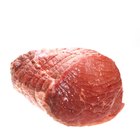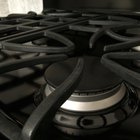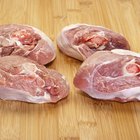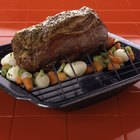Braising employs slow cooking and both dry and moist heat to break down the fibrous connective tissues in less tender cuts of meat, such as chuck roast or flank steak. As a result, even tough, inexpensive meats become tender and succulent. As an added benefit, braising is a one-pan cooking method with little cleanup required, a boon for the busy parent. Although braising is easy, doing it correctly requires time and patience.
Cookware
Because braising involves a two-part cooking process, proper cookware is important. Dutch ovens are often used for braising, because they are easily moved from the stovetop to the oven. A large saute pan or cast iron skillet also works as long as the pan is heatproof and has a securely fitting lid. Avoid pans that are excessively large, as too much space allows steam to develop. In turn, droplets of moisture drip onto the meat and into the sauce.
Searing
Searing is the critical first step to successfully braising tough, inexpensive cuts of meat. Once the meat is seared, you can relax and let the meat cook slowly. To sear a tough cut, season the meat with salt and pepper or a packet of salad dressing mix. Pour enough cooking oil to cover the bottom of the Dutch oven or pan. Heat the oil over medium-high heat, then sear the meat just until both sides are brown.
Liquid
Once the meat is seared, it's time to add liquids to provide flavor and moisture, which will diffuse into the meat for the remainder of the cooking time. Remove the meat from the pan and put it on a plate so you can use a heatproof spatula to loosen flavorful bits of meat stuck to the bottom of the pan. Return the meat to the pan and add liquid. Water is fine for braising, but liquids such as broth, cider, beer or wine add flavor to the braised meat. Fill the Dutch oven or pan with liquid halfway up to the top of the meat.
Braising
Braising involves cooking the meat slowly in an oven preheated to about 325 degrees Fahrenheit. Depending on the thickness of the meat, braising may take as long as six hours. To braise the meat, place the lid on securely, then put the Dutch oven on a rack in the center of the oven. Or braise meat on the stovetop. Bring the liquid to a boil, then reduce the heat to a simmer and cover the vessel. Either way, check the pan occasionally and adjust the meat if necessary so the liquid remains at a gentle simmer. If the liquid is too hot, the meat becomes tough, but cooking at a heat that is too low may cause growth of bacteria. Check the temperature with a meat thermometer to ensure that the liquid simmers at a temperature of 180 to 190 degrees Fahrenheit. The meat is done when it is tender and falls apart easily.
Related Articles

How to Cook a Rolled Beef Chuck Roast ...
How to Cook Roast Beef in a Cast-Iron ...

How to Cook Center Cut Chuck Steak

How to Cook the Neck of a Deer

How to Cook Corned Beef Without Being ...

How to Cook Boneless Beef Shank
How to Slow Cook a Pot Roast With Beef ...
How to Cook Brisket Slowly With a ...

How to Cook an 8- to 10-Pound Beef ...

How to Cook Texas Broil Roast

How to Cook a Really Tender Beef Roast ...

How to Cook Beef Top Round Pot Roast

How to Cook a Beef Roast in a Roaster ...

How to Cook Beef Topside in a Slow ...

How to Cook Muskrat
How to Cook a Bottom Round Roast & ...

How to Cook Boneless Country Spare Ribs

How to Cook a Whole Beef Shank Roast

How to Cook Tender Rolled Flank Steaks ...

How to Cook a Deer Neck Roast in a Slow ...
References
Writer Bio
M.H. Dyer began her writing career as a staff writer at a community newspaper and is now a full-time commercial writer. She writes about a variety of topics, with a focus on sustainable, pesticide- and herbicide-free gardening. She is an Oregon State University Master Gardener and Master Naturalist and holds a Master of Fine Arts in creative nonfiction writing.